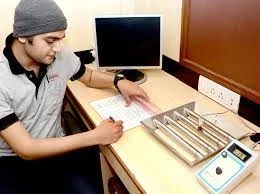Magnet testing is an essential process to ensure the quality, performance, and reliability of magnets used in various applications. Whether it's permanent magnets used in motors, generators, magnetic separators or electromagnets used in MRI machines or other specialized equipment, thorough testing is crucial to detect potential defects, anomalies, or performance issues. In this blog, we will discuss a magnet testing checklist that can be used during a test to ensure comprehensive and accurate inspection.
Visual Inspection: The first step in any magnet testing process is a visual inspection. This involves a thorough examination of the magnet's surface for any visible defects, such as cracks, chips, corrosion, or other signs of damage. The visual inspection should also include checking for any irregularities in the magnet's shape, size, or surface finish. It is essential to ensure that the magnet is free from any visible defects that may affect its performance or integrity.Magnet Audit: A magnet audit involves verifying the magnet's specifications, including its material composition, dimensions, and magnetic properties, against the specified requirements or standards. This can be done by referring to the manufacturer's documentation or by performing measurements using appropriate tools, such as calipers, micrometers, or magnetometers. A magnet audit ensures that the magnet meets the intended application requirements and can provide the desired magnetic performance.Non-Destructive Testing (NDT) Methods: Non-destructive testing methods, such as magnetic particle inspection (MPI), eddy current testing (ECT), ultrasonic testing (UT), and remote visual inspection (RVI), are commonly used to detect surface and near-surface defects or anomalies in magnets without altering or damaging the magnet. These methods can provide reliable results and are suitable for both manual and automated inspection processes. The specific NDT method used may depend on the type of magnet, the size and type of defects being targeted, and the inspection requirements.Magnetic Particle Inspection (MPI): MPI is a widely used NDT method for detecting surface and near-surface defects in ferromagnetic materials. It involves applying magnetic particles to the magnet's surface and using a magnetic field to attract and concentrate the particles around any defects or cracks, making them visible under UV light or with the naked eye. MPI is sensitive to surface defects, such as cracks, chips, or other signs of damage, and can provide accurate results.Eddy Current Testing (ECT): ECT is a non-contact NDT method that uses electromagnetic induction to detect defects or anomalies in conductive materials, including magnets. It involves passing an alternating current through a coil or probe and measuring the induced electromagnetic fields in the material. Changes in the electromagnetic fields caused by defects, such as cracks or discontinuities, can indicate potential issues in the magnet's integrity or performance.Ultrasonic Testing (UT): UT is a widely used NDT method that uses high-frequency sound waves to detect defects or anomalies in materials, including magnets. It involves sending ultrasonic waves into the material and measuring the reflections or echoes from the waves to identify any changes in the material's properties, such as cracks or voids. UT can provide accurate results for detecting both surface and subsurface defects in magnets.Remote Visual Inspection (RVI): RVI involves using specialized equipment, such as borescopes or cameras, to visually inspect the magnet's internal or hard-to-reach areas without damaging the magnet. RVI can be used to detect defects, anomalies, or other signs of damage that may not be visible during a regular visual inspection. It is particularly useful for inspecting complex or intricate magnet assemblies or electromagnets.
Destructive Testing Methods: Destructive testing methods, such as microstructure analysis, chemical analysis, mechanical testing, thermal testing, and electrical testing, involve altering or damaging the magnet to examine its internal structure, chemical composition, mechanical properties, thermal behavior, or electrical characteristics. These methods are typically used when more detailed or in-depth information about the magnet's properties or performance is required and are not suitable for all types of magnets or applications.Microstructure Analysis: Microstructure analysis involves examining the magnet's internal structure at a microscopic level to assess its grain size, grain boundaries, and other microstructural features. This can provide insights into the magnet's manufacturing process, heat treatment, and overall quality. Microstructure analysis can be performed using techniques such as optical microscopy, scanning electron microscopy (SEM), or transmission electron microscopy (TEM).Chemical Analysis: Chemical analysis involves determining the chemical composition of the magnet, including the elemental composition and impurity levels. This can be done using techniques such as X-ray fluorescence (XRF), energy-dispersive X-ray spectroscopy (EDX or EDS), or inductively coupled plasma (ICP) spectroscopy. Chemical analysis can provide valuable information about the magnet's material properties, alloy composition, and potential impurities that may affect its performance.Mechanical Testing: Mechanical testing involves evaluating the magnet's mechanical properties, such as its tensile strength, hardness, toughness, or fatigue resistance. This can be done using standard mechanical testing methods, such as tensile testing, hardness testing, or impact testing. Mechanical testing can provide insights into the magnet's structural integrity, durability, and performance under different loading conditions.Thermal Testing: Thermal testing involves subjecting the magnet to different temperature conditions to assess its thermal behavior, such as its coefficient of thermal expansion, Curie temperature, or thermal stability. This can be done using techniques such as differential scanning calorimetry (DSC), thermogravimetric analysis (TGA), or thermal cycling. Thermal testing can help determine the magnet's suitability for high-temperature applications or its vulnerability to thermal degradation.Electrical Testing: Electrical testing involves measuring the magnet's electrical properties, such as its resistivity, conductivity, or magnetic properties under different electrical conditions. This can be done using techniques such as electrical resistivity measurement, magnetic hysteresis loop measurement, or impedance spectroscopy. Electrical testing can provide insights into the magnet's electrical performance, magnetic behavior, and suitability for specific applications.
Documentation and Reporting: It is essential to document and report the results of magnet testing accurately. This includes recording all the inspection methods used, the findings, and any deviations from the specified requirements or standards. The results should be documented in a comprehensive report that includes all relevant information, such as the magnet's specifications, inspection methods, results, and recommendations for further actions, such as repair, replacement, or retesting. Proper documentation and reporting ensure that the magnet's testing process is traceable, auditable, and transparent, and can serve as a reference for future inspections or quality control purposes.
Conclusion -
magnet testing is a critical process to ensure the quality, performance, and reliability of magnets used in various applications. A comprehensive magnet testing checklist should include visual inspection, magnet audit, non-destructive testing methods such as magnetic particle inspection (MPI), eddy current testing (ECT), ultrasonic testing (UT), remote visual inspection (RVI), and potentially destructive testing methods such as microstructure analysis, chemical analysis, mechanical testing, thermal testing, and electrical testing. Proper documentation and reporting of the testing results are also crucial. Following a thorough magnet testing checklist can help detect potential defects, anomalies, or performance issues in magnets, and ensure that only high-quality magnets are used in critical applications.
PERMAG is a leading supplier of magnetic grill, and we are committed to providing our customers with the highest quality products available on the market. Thanks to our state-of-the-art manufacturing process, we are able to produce magnetic rods that meet the most stringent quality standard.


